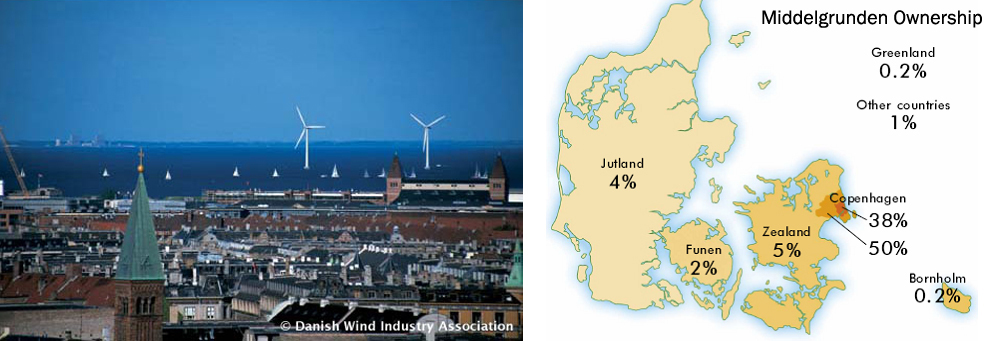Copenhagen, Denmark
Middelgrunden Wind Farm
(20) 2 MW turbines (equivalent to 20,000 Danish homes)
Development Timeline: 1996 - 2000
Owners: Middelgrunden Wind Turbine Cooperative and Copenhagen Energy (City of Copenhagen) each have 50% ownership.

In Denmark, over 14% of Danish electricity consumption is provided by wind, and more than 150,000 Danish families are members of wind turbine cooperatives.(1) Cooperative ownership arrangements have been used extensively in Denmark, though in the case of the wind "cooperatives", they are technically structured as general partnerships. The partnerships are contractual relationships among many partners, which allow people to pool resources and directly own a project. Generally speaking, the partnerships in Denmark sell the power to the local utility.(2)
Project History:
In 1996, the Copenhagen Environment and Energy Office (CEEO) took the initiative to organize the project and created a working group comprised primarily of local citizens interested and optimistic about the prospect of wind power in the region. In 1997, the Middelgrunden Wind Cooperative was established with the mission to produce wind electricity through the construction and management of off-shore wind turbines located in a shoal off the coast of Copenhagen. Around the same time, the Danish Energy Authority mapped the shoal at Middelgrunden as a potential site for wind development, but the project was not prioritized by the government and power utility. However, Parliament was supportive of the idea and authorized funding for further investigations. The support of 1,000 members of newly formed cooperative, along with the support from the government helped paved the way for the project.
Two public hearings were held in 1997 and 1998, and addressed concerns primarily dealing with the visual impact of the project, reducing the scale from 27 to 20 (more efficient) turbines. In 1999, a final hearing was held, which focused on the environmental impact assesment. Final approval for project was given with support from a broad array of stakeholders, with just a small number of yachtsman, fisherman, politicians, and other individuals opposed to the project.
The wind farm was constructed in the year 2000 and annually produces 3% of the total electricity consumption of Copenhagen.(3)
Site:
The wind farm is located just 2km offshore, near a very popular beach in Copenhagen. Initially, there were concerns about visual impact and there was inititally some public resistance to wind turbines in the urban landscape. The Middelgrunden Cooperative and the Copenhagen Energy and Environment Office invested large amounts of time and resources into generating public support and acceptance for the project, contacting between 50-100,000 people. Stakeholders and interested groups were involved in the process before investigations and planning began, and 10,000 people pre-subscribed for shares in the cooperative.
Ownership:
The Middelgrunden Wind Farm is jointly owned by the Middelgrunden Wind Turbine Cooperative and the local utility, Copenhagen Energy Wind, a part of Copenhagen Energy. The cooperative is set up as a partnership, and one share equals 1/40,500 of the partnership. There are 8,552 electricity consumers who are co-owners of the wind farm, and most of these people live in the greater Copenhagen area.
All investment costs were shared between these two developers and they collaborate on the operations. However, the cooperative owns and manages the 10 southern turbines, and the utility owns and manages the 10 northern turbines. However, they both collaborate on the operations.
All cooperative shares were paid up-front according to the constitution of the cooperative. One share represents the production of 1,000 kWh/year and sold for 4,250 DKK (567 EUR).(4) Currently, more than 8,500 people are members of the cooperative, and by 2000, 100% of the private shares were sold.(5)
"Your Own Pigs Don't Stink": (reputedly a Danish folk saying)
In Denmark, wind projects that are owned by outsiders (not locally owned) generally receive less community acceptance, and local ownership of the project was an advantage for overcoming public resistance. 90% of the Middelgrunden cooperative's shares are owned by residents of greater Copenhagen (See map below). The Danish Society for the Conservation of Nature at first rejected the proposal, but the local committee was in favor. Many local members approached the mass media and opposed the decision of the national board, which revised its decision in the end.(1)
Reportedly, changes in the Danish wind industry in the years since the Middelgrunden project have already led to local protests against wind farms owned by large utilities. The Danish Wind Industry has warned of the consequences, citing a 1996 University of Amsterdam study: "Public resistance to wind projects is not so much against the turbines themselves, but also against the people who want to build [them]."(6)
"The big utilities are moving in because they see the chance to make a lot of money with offshore wind parks.“
- Preben Maegaard, Nordic Folkecenter for Renewable Energy (6)

Photo credits: All unlabeled images from www.middelgrunden.dk
Sources:
* Much of the information on this page is abbreviated from the report "Wind Options: A Study of Energy Ownership Models" written by Kara Reeve, Jonathan Cherry, Peter Banks, and Carlos Espinoza-Toro in the Fall 2007 MIT course 11.965 Cooperatives and Community Economic Development.
1) “The Middelgrunden Offshore Wind Farm: A Popular Initiative” Brochure from the Middelgrunden Wind Turbine Cooperative <www.middelgrunden.dk>
2) Stamford, Michael C. “Community Ownership: The best way ahead for UK Windpower?” Paper for Masters Degree at University of East Anglia, Norwich, 2004.
3) Danish Wind Energy Association. <www.windpower.org/en/pictures/offshore.htm>
4) Sorensen, Hans Christian. “Middelgrunden 40 MW Offshore Wind Farm Denmark – Lessons Learned.” Realities of Offshore Wind Technologies, Case: Middelgrunden, Orkney, October 2002.
5) Larsen, Jens H, Soerensen, Hans Christian. “Experience from Middelgrunden 40 MW Offshore Wind Farm.” European Wind Energy Conference, 2001. <middelgrunden.dk/artikler/Copenhagen%20Offshore%207%20Middelgrund.pdf>
6) Poetter, Bernhard. “People Power Danish Style: Why European and American Winds Blow in Opposite Directions.” Onearth. Natural Resource Defense Council, Summer 2007.<www.onearth.org/article/people-power-danish-style>
|
